ISSN ONLINE(2319-8753)PRINT(2347-6710)
ISSN ONLINE(2319-8753)PRINT(2347-6710)
Hanumantharaya R1, Ananda Kumar K M2, Prem Kumar B G1 ,Vikas G1 ,Ashok Kumar G P1
|
| Related article at Pubmed, Scholar Google |
Visit for more related articles at International Journal of Innovative Research in Science, Engineering and Technology
This paper concentrates on the comparative study on frictional performance of glass-epoxy composite with influence of Granite and fly ash filler are experimentally investigated under constant load and sliding velocity, varying sliding distance using a pin-on-disc apparatus. Composites were fabricated by standard hand layup technique followed by hot pressing. The wear behaviour of the composites have been performed at varying abrasive distances viz., 5, 10, 15 20 and25 m at a constant load of 10 N. The experiment has been conducted using two different water proof silicon carbide (SiC) abrasive papers of 320 and 600 grit size at a constant speed of 200 rpm under multi-pass condition. The results show that wear loss of the composites was found increasing with the increase in abrading distances. A Significant reduction in wear loss and specific wear rates were noticed after incorporation of SiC and fly ash filler into GE composite.
Keywords |
| Two-body abrasive wear, Glass-fabric, Epoxy-composites, Silicon carbide, fly ash Wear mechanisms. |
I. INTRODUCTION |
| There is an escalating stipulate for advanced materials with better properties to meet new requirements or to replace existing materials. The high performance of continuous fiber (e.g. carbon fiber, glass fiber) reinforced polymer matrix composites is well known and documented [1] Polymer based composites have been increasingly used for numerous Tribological applications such as seals, gears, bearings, cams, wheels, brakes and clutches, for they have the ability to provide light weight alternatives to conventional materials. Polymer composites are promising in Tribological applications due to the possibility of tailoring their properties with special fillers such as MoS2, Al2O3, graphite, tungsten carbide, tantalum, niobium, bronze and silicon carbide (SiC) [2-3]. |
| In this study an attempt has been made to study the effect of fly ash and granite filler on the wear behaviour of glass epoxy composites. The wear of polymer matrix composite with different reinforcements is the topic of investigation in recent days .Wear is defined as damage to a solid surface, generally involving progressive loss of material, due to relative motion between the contacting surfaces. Two-body abrasive wear is a complex process often involving high strain and plastic deformation and fracture of micro volumes of the material, which might be described as the removal of discrete surface by a harder substance which tends to gauge, score, or scratch[4]. Two-body abrasion test has been conducted with abrasive papers or rough metal counter faces where abrasive is fixed. In fact, in practical applications, many components, for example, conveyor belt, shuttle, tillage tools and wind blades are subjected to twobody abrasive wear. |
II. RELATED WORK |
| Suresha et al. [5] investigated abrasive wear behaviour of SiC and graphite fillers filled glass fabric-vinyl ester composites. They concluded that SiC filled composite showed excellent abrasion resistance compared to unfilled composites. Basavarajappa et al. [6] investigated the Abrasive Wear Behaviour of Granite-Filled Glass-Epoxy Composites by SiC Particles Using Statistical Analysis. The obtained results indicate that applied load and sliding distance were the factors that have the highest physical as well as statistical influence on the abrasive behaviour of both filled and unfilled composite. Anand Chairman et al [7] studied the two-body abrasive wear behavior of Glass–Epoxy (G–E) composites by the addition of Titanium carbide (TiC) as a secondary reinforcement using pin-on disc equipment at an applied load of 5, 10 and 15N for various sliding distances (25, 50,75m) with 400 grit water proof Silicon Carbide (SiC) abrasive paper The two-body abrasive wear behavior of Glass–Epoxy (G–E) composites has been evaluated by the addition of Titanium carbide (TiC) as a secondary reinforcement using pin-on disc equipment at an applied load of 5, 10 and 15N for various sliding distances (25, 50,75m) with 400 grit water proof Silicon Carbide (SiC) abrasive paper Bhadrabasol Revappa Raju et al [8] studied the mechanical and two-body abrasive wear behaviour of alumina (Al2O3) filled glass fabric reinforced epoxy (G-E) composites The results show that in abrasion mode, as the filler loading increases the wear volume decreases and increased with increasing abrading distance. The excellent wear resistance was obtained for Al2O3 filled G-E composites. Furthermore, 10 wt% filler loading gave a very less wear loss. Finally, the scanning electron micro-scopic observations on the wear mechanisms Al2O3 filled G-E composites was discussed. Ajit Kumar Senapati et al [9] made an attempt to provide an extensive literature review on the overall performance of these fly ash reinforced composites. Literatures in each category are reviewed according to the key factors mentioned. The literature review framework in this paper provides a clear overview of the usage of fly ash as a reinforcing agent in different matrices along with its distinctive performances. |
| N. Mohan et al[10] studied the effect of silicon carbide (SiC) particulate fillers incorporation on two-body abrasive wear behaviour of Glass Fabric - Epoxy (GE) composites, The wear behaviour of the composites were performed using pin-on-disc tester at varying abrasive distances viz., 25, 50, 75 and 100 m at a constant load of 10 N. The experiment was conducted using two different water proof silicon carbide (SiC) abrasive papers of 600 and 1000 grit size at a constant speed of 200 rpm under multi-pass condition. The result indicates that the significant influence of SiC filler allowing less wear of matrix during abrasion. |
| From the literature survey it is clear that there is lot of scope for the study of abrasive wear behaviour of PMC’s. Hence present study has been focused on the two body abrasive wear behaviour of Glass – Epoxy composite and the effect of granite and fly ash fillers. Further the main aim is to investigate the effect of applied load, abrading distance, sliding speed and abrasive particle size. |
III. EXPERIMENTAL DETAILS |
| a. Materials |
| The matrix material used here is medium viscosity epoxy resin (LAPOX L-12) supplied by ATUL India Ltd., Gujarat, India. Woven glass plain fabrics made of 360 g/m2, containing E-glass fibers of diameter of about 12 μm have been used as the reinforcing material in all the composites and room temperature curing polyamine hardener (K-6). This matrix has been chosen, since it provides good resistance to alkalis and good adhesive properties. The filler used here is granite and coal burned fly ash passed through sieves. The details of the material combination and percentage of filler materials are given in Table 1 |
 |
| b. Fabrication |
| A hand lay-up technique is adopted to prepare the glass-epoxy composites with filler. To prepare the filled glass-epoxy composites, filler is mixed with a known amount of epoxy resin. The composites are fabricated and cured as reported by Suresha et al. [5] and Basavarajappa et al. [6] The cured materials are cut to yield abrasive wear test specimen of size 6mm×6mm×3mm As regards to the processing, on a Teflon sheet, E-glass woven fabric was placed over which the epoxy matrix system consisting of epoxy and hardener was smeared. Dry hand lay-up technique has been employed to fabricate the composites. The stacking procedure consists of placing the fabric one above the other with the resin mix well spread between the fabrics. A porous Teflon film has been again used to complete the stack. To ensure uniform thickness of the sample, a 3 mm spacer has been used. The mould plates were coated with re-lease agent in order to aid the ease of separation on curing. |
| c. Two-Body Abrasive Wear Test |
| Two-body abrasive wear tests were performed using a Pin-on-Disc machine according to ASTM G99 standards. Test samples were prepared after proper cutting and polishing to 6 mm × 6 mm × 3 mm size. The composite sample has been abraded against the water proof silicon car-bide (SiC) abrasive papers of 320 and 600 grit size at a constant velocity of 1 m/s speed in multi-pass condition. During wear test, the sample is so placed in such a way that the fibers are parallel and anti-parallel with respect to the abrading direction and the abrading plane. A constant normal load of 10 N was applied. The weight loss measurements were carried out for five abrading distance of 5, 10, 15, 20 and 25 m. Before and after wear testing, samples were cleaned with brush to remove wear debris. The wear has been measured by the loss in weight (Mettler: TOLEDO, 0.1 mg accuracy),The differences in the weight measured before and after the test gave the dry sliding wear loss of the composites, which has been converted into the volume loss. The specific wear rate (Ws) has been calculated using Eq 1. Where V is the volume loss, L is the applied load, and D is the sliding distance. |
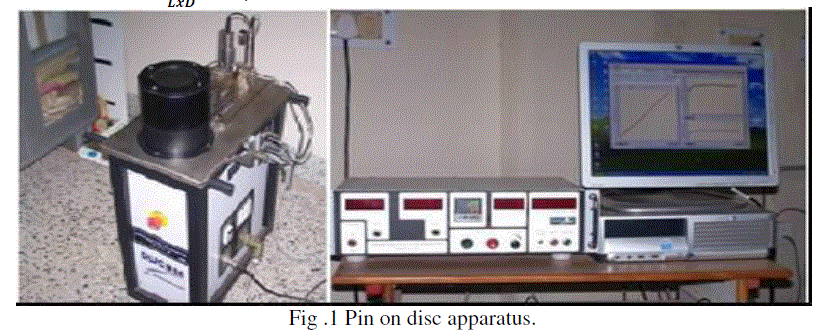 |
| d. Scanning Electron Microscopy |
| The surfaces of the worn out samples were examined through a scanning electron microscope. Before the examination, a thin gold film has been coated on the worn out surface by sputtering to get a conducting layer. The worn surface features of the selected specimens are given below. |
| IV. RESULTS AND DISCUSSION |
| a. Effect of Sliding Distance on weight loss |
| The variation in weight loss of composites worn against 600 and 320, grit SiC paper at 10 N against abrading distance under multi-pass condition is shown in Figures (a) and (b) respectively. The wear data of the composites reveal that the weight loss tends to increase near linearly with increasing abrading distance and strongly depends on the grit size of the abrasive paper. From Figures (a) and (b), it is obvious that the weight loss of composites worn on two different SiC papers increased with increasing abrading distance. Weight loss of unfilled G-E is much higher than those of Granite and fly ash filled G-E- composites and also the weight loss decreased with the addition of 5 % fly ash filler. In addition, the highest weight loss is observed from specimens worn against 320 grit SiC paper compare to 600 grit SiC paper, from the literature review it has been observed that the addition of fly ash as a filler material to epoxy matrix will enhance the mechanical properties like impact strength, stiffness, hardness which intern increases the wear resistance [7] |
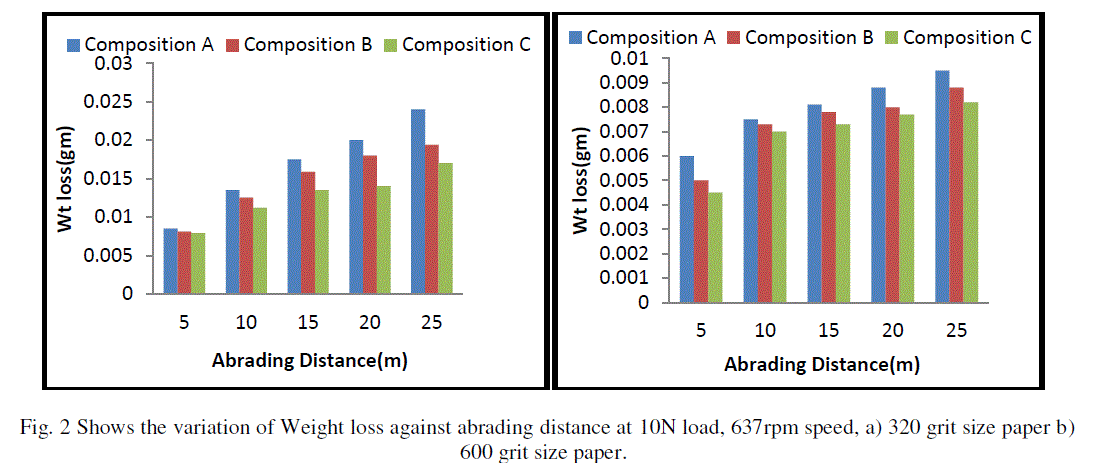 |
| As shown in Figures 2(a) and (b), the weight loss of the unfilled composites has been found to be greater than that of filled G-E composite. When the specimens were worn at a 10 N load with 320 grit SiC paper, wear debris did not adhere to the SiC paper. However, in the specimen worn under the same test conditions except the grit size of SiC (600 grit), some abrasive particles penetrated more into the matrix. The fine particles which were detached from the counter surface (SiC abrasive paper) fill the cavities and modified the specimen surface. Therefore, the weight loss with 600 grit SiC paper decreased when compared to 320 grit SiC paper. [8] The weight loss is less in unfilled G-E composites and it can be attributed to inherent better mechanical properties with the addition of granite and coal burnt fly ash. |
| b. Effect of abrading distance on specific wear rate |
| Figure 3 (a) and (b) shows variation in specific wear rate against abrading distance at constant load 10N and speed 637 rpm by varying 320 and 600 grit size paper respectively. The wear data reveals that the specific wear rate tends to decrease linearly with increase in abrading distance from 5m to 25m. The unfilled A composite shows more specific wear rate as compared to other composites. |
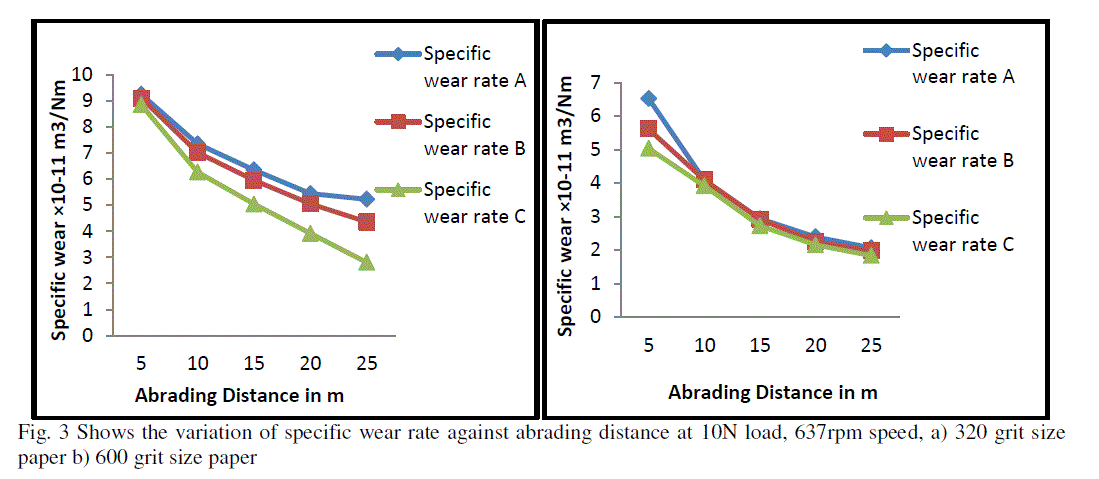 |
| The results reveal that higher abrading nature of A composite compared to filled B and C, the phenomenon of decrease in specific wear rate due to the nature of fabric. Suresha, Chandra Mohan et, al. [5] reported that composites fabricated by hand lay-up technique, characterized by the resin rich top layer. Abrasive wear tests were performed on as Silicon carbide sand paper surface of the composite without disturbing its original surface. Thus, in the initial stage of abrasion, abrasive is in contact with matrix and has less hardness as compared to that of angular silica sand. At the particular instance, the ratio of Ha (hardness of abrasive particle) to Hs (hardness of the surface) is much more than unity, resulting in severe matrix damage and the rate of material removal is very high. Similarly when glass fibers are in contact with abrasive particles fibers provide better resistance to the process of abrasion, At higher sliding distance (25 m) the A composite shows less specific wear rate as shown in Figure. The specific wear rate decreases with increasing in abrading distance for unfilled A composite. This is due to extensive debris formation with large number of broken fibers are seen. |
| The filled B and C composite shows less specific wear rate as compared to unfilled A composite as shown in Figure 3. The specific wear rate decreases with increasing in abrading distance for filled B composite. Basavarajappa et, al. [6] explained that at initial stage epoxy matrix wear out is higher as sliding distance progresses the granite and fly ash particles protrude out from the sample surface. At this instance, the granite particles along with the exposed glass fibers wear the counter surface leading to decrease in specific wear rate. |
V. WORN SURFACE MORPHOLOGY |
| The worn surface features of the composite specimen were examined using a scanning electron microscope (SEM). The SEM features of the worn surfaces of unfilled and granite, fly ash filled GE composite samples at a constant load of 10 N for two abrasive SiC papers (600 and 320 grit) and at constant velocity with abrading distances (25 m) are shown in Figs. Several mechanisms have been proposed to explain how material is removed from the surface during abrasion. Because of the complexity of abrasion, no one mechanism completely contributes to all the wear loss. In general, the abrasive wear process involves four different mechanisms namely microploughing, microcutting, microfatigue and micro- cracking. [8] With the help of SEM photomicrographs it is possible to identify qualitatively the dominant wear mechanisms under abrasion. |
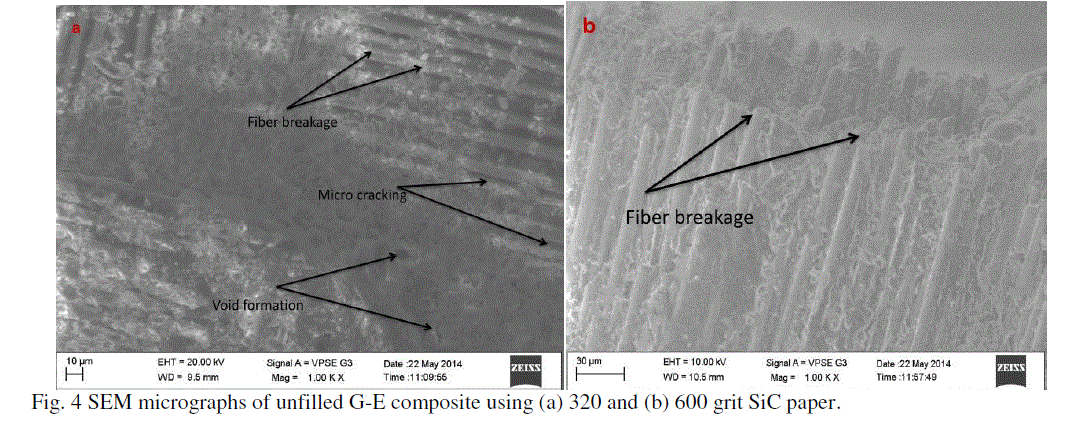 |
| The surface features of unfilled GE composite worn surfaces abraded at 25 m with grit size of 320 and 600 as shown in Fig. 4. SEM images of coarse grit (320μm) depicted that more damage to the epoxy matrix and glass fibers as compared with that fine grit (600 μm). Fig. 4(a) shows some ploughing marks on the surface, matrix damage and exposure of glass fibers. These exposed fibers tend to fracture and their removal from the surface of the composite. The matrix is heavily damaged by ploughing and cutting action by the higher sized SiC particles. Overall surface topography indicated more fiber pulverization, more fiber breakage and less fiber matrix debonding. |
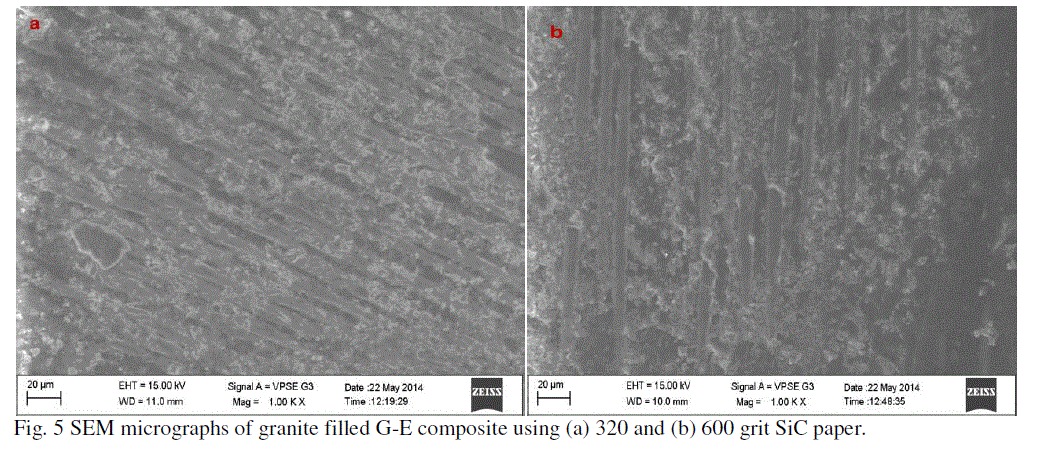 |
| Fig. 5(a) and (b), shows SEM images of granite filled G-E composite, it has been observed that in both cases of abrasive grit size of 320 and 600, there exist less wear debris on the worn surfaces, leading to improved wear resistance. On the worn surface of composite abraded against 320 grit SiC paper, the abrasive grooves are narrow and wider Fig. 5(a). However, the worn surface of the same samples were slided against 600 grit SiC paper indicates shallow and no grooves due to the smaller size of the abrasive particles Fig. 5(b). Comparing the photomicrographs of the composites tested, the extent of damage is less in the case of unfilled G-E composite. |
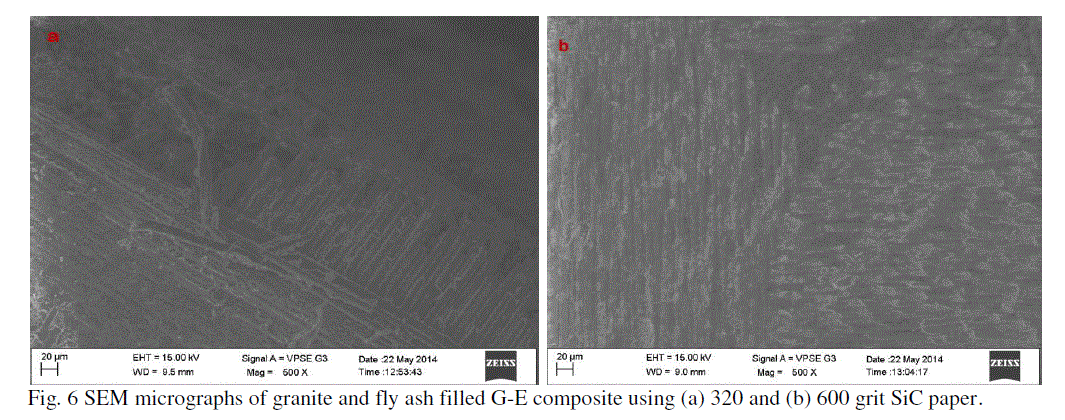 |
| Fig. 6(a) and (b), shows SEM images of worn surface of GE granite and fly ash filled composite at 600 grit SiC paper at 25m showed smooth surfaces less matrix damage and matrix is well bonded with fiber and it protects the fiber in position as shown in Fig. 4a where as SEM images at higher abrading distance 100 m showed rough surface. Fig. 4b also reveals formation of fiber skin. This result clearly indicates as abrading distance increases wear loss also increases. |
VI. CONCLUSIONS |
| From abrasive wear studies of glass epoxy, granite and fly ash reinforced composites the following conclusions can be drawn: |
| Investigation on the effectiveness of granite and fly ash on the wear performance of composites has been reported. Among the composites, maximum enhancement in wear performance is observed in granite and fly ash reinforced glass-epoxy composites by the weight loss calculations. |
| Specific wear rate decreased with abrading distance and increased with increasing abrading grit size. Granite and fly ash reinforced glass-epoxy composites showed better abrasion resistance as compared to that of unfilled G–E composite. |
| The results of the morphology study of the wear test specimens support the results of the wear test. |
References |
|